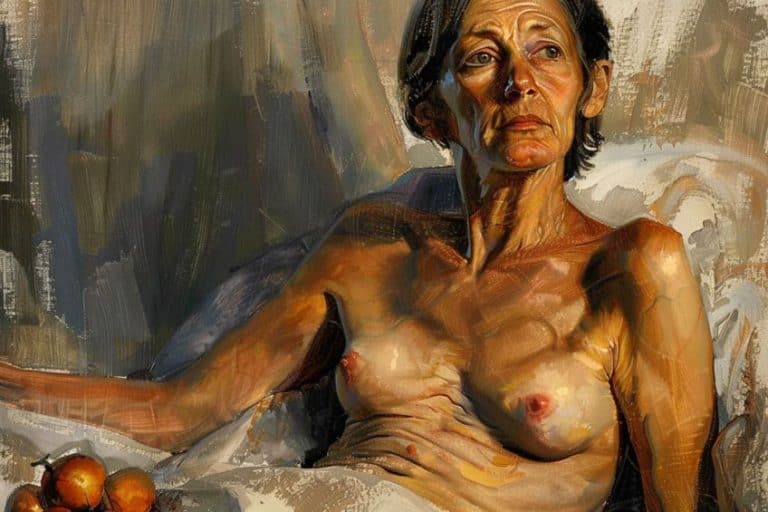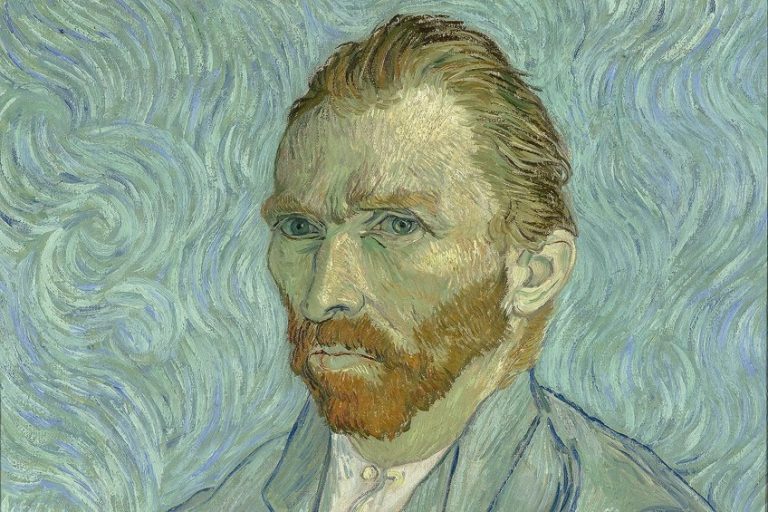“Great Red Dragon and the Woman Clothed in Sun” – William Blake
William Blake was one of the foremost English Romanticists, an artist of many skills who walked the line between the real and sublime. This article will discuss his watercolor The Great Red Dragon and the Woman Clothed in Sun (c. 1805) in more detail.
Artist Abstract: Who Was William Blake?
The English artist William Blake was born on 28 November 1757 and lived until 12 August 1827. He was born in London to James Blake and Catherine Wright and did not have traditional schooling but was also taught by his mother. He attended the Henry Pars Drawing School on the Strand in London in 1767, which is when he was ten years old, and he was also an apprentice for around seven years for the engraver James Basire.
Blake produced various artworks throughout his career that were based on themes around spirituality and the cosmos.
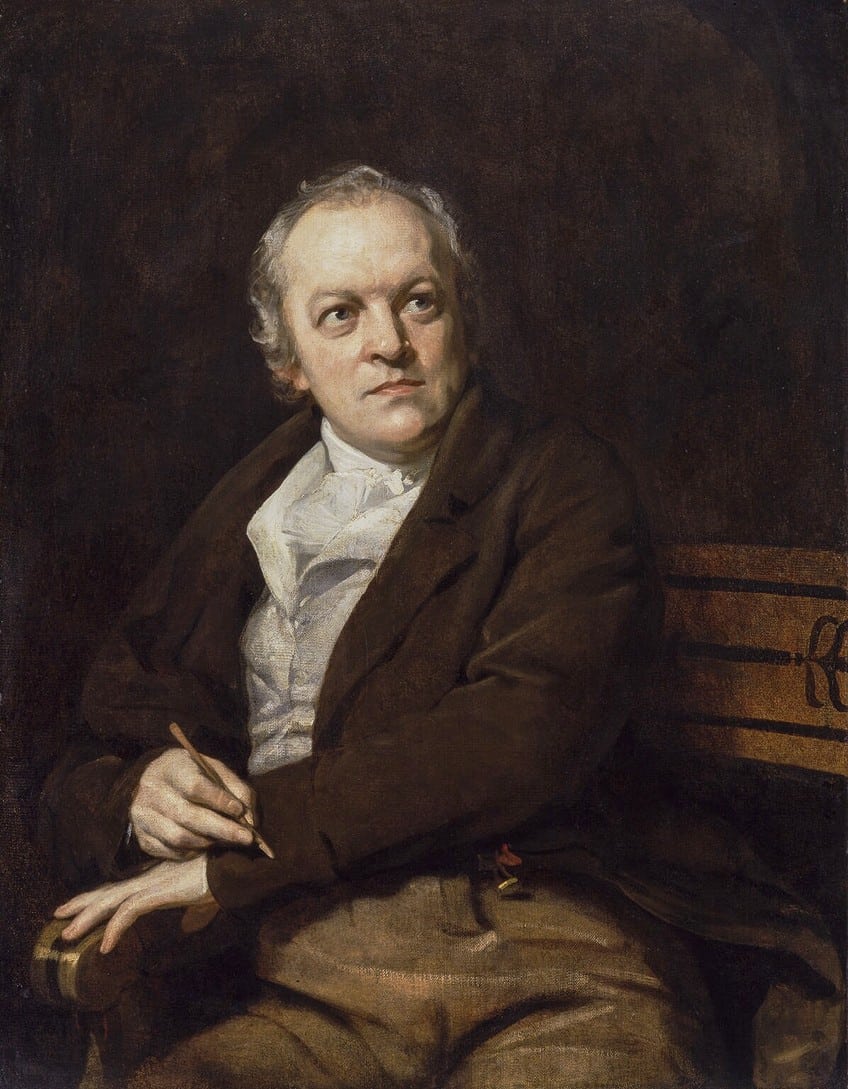
These were often around concepts about good and evil and with references to the Bible, mythology, and literature with his poetry often underlying his paintings. Some of his famous art pieces include Ancient of Days (1794), Pity (1795), and The Angels Hovering Over the Body of Christ in the Sepulchre (c. 1805).
The Great Red Dragon and the Woman Clothed in Sun (c. 1805) by William Blake in Context
| Artist | William Blake (1757 – 1827) |
| Date Painted | c. 1803 – 1805 |
| Medium | Pen and ink, watercolor, and graphite |
| Genre | Religious painting |
| Period / Movement | Romanticism |
| Dimensions (cm) | 43.7 x 34.8 |
| Series / Versions | Part of a series of paintings about The Book of Revelations (c. 96 CE) from the Holy Bible |
| Where Is It Housed? | Brooklyn Museum, New York City, United States of America |
| What It Is Worth | Uncertain |
The article below will discuss the watercolor The Great Red Dragon and the Woman Clothed in Sun (c. 1805) by William Blake, however, it is important to note that this is one version of three other paintings by Blake based around themes in The Book of Revelation (c. 96 AD) from the Holy Bible’s New Testament. Furthermore, this is the version that we will discuss in the formal analysis below.
Contextual Analysis: A Brief Socio-Historical Overview
The Great Red Dragon and the Woman Clothed in Sun by William Blake was commissioned by Thomas Butts, who was an Assistant Commissary of Musters as well as one of Blake’s patrons who supported him with various art commissions, interestingly Blake was an engraving teacher for Thomas Butts’ son.
Reportedly, Thomas Butts commissioned over 100 paintings that were related to Biblical themes.

However, Blake’s dragon features in more than one commission by Thomas Butts, and included three other versions, namely The Great Red Dragon and the Woman Clothed With the Sun (c. 1805), which is held at the National Gallery of Art in Washington, D.C, United States of America, The Great Red Dragon and the Beast from the Sea (c. 1805), which is also held at the National Gallery of Art, and the third version is The Number of the Beast is 666 (c. 1805), which is held at the Rosenbach Museum and Library in Philadelphia, United States of America.
What Is the “Great Red Dragon”?
The “Great Red Dragon” refers to the dragon from The Book of Revelation in the Holy Bible, which is known as the final book of the New Testament, of which Chapter 12 titled “The Woman and the Dragon” is often cited to provide contextual meaning to Blake’s dragon.
The chapter is about a woman giving birth and a dragon standing in front of her that wants to kill her newborn.
The abovementioned verse is described, in parts, as follows, from verse one, the woman is described as “clothed with the sun, with the moon under her feet and a crown of twelve stars on her head”. The dragon is introduced as an “enormous red dragon with seven heads and ten horns and seven crowns on its heads”.

In The Book of Revelations, Chapter 12, mentioned above, the newborn child symbolizes Jesus Christ, and the woman is the Virgin Mary who is accosted by the Devil that wants to prevent Jesus to lead the Christian faith, however, there are other meanings that are drawn from Blake’s dragon paintings, notably socio-political ideas. The French Revolution, which took place between 1789 and 1799, has also been referenced as a possible influencing factor to the theme around good and evil in William Blake’s dragon paintings.
William Blake in Pop Culture
William Blake’s dragon has also famously featured in the 21st-century film Red Dragon (2002), which was directed by Brett Ratner, in which one of the characters is a serial killer Francis Dolarhyde, who has an alter ego/personality called “The Great Red Dragon”. He also has a rendition of Blake’s dragon as a tattoo covering his entire back.
Interestingly, in the film, the character also consumes the painting at the Brooklyn Museum to attempt to quell the alternate personality in him.
Formal Analysis: A Brief Compositional Overview
The formal analysis will discuss The Great Red Dragon and the Woman Clothed in Sun by William Blake, which is housed at the Brooklyn Museum in New York City. We will provide a detailed analysis in terms of the art elements like color, texture, line, shape, form, and space, as well as how the art principles also contribute to the stylistic composition.
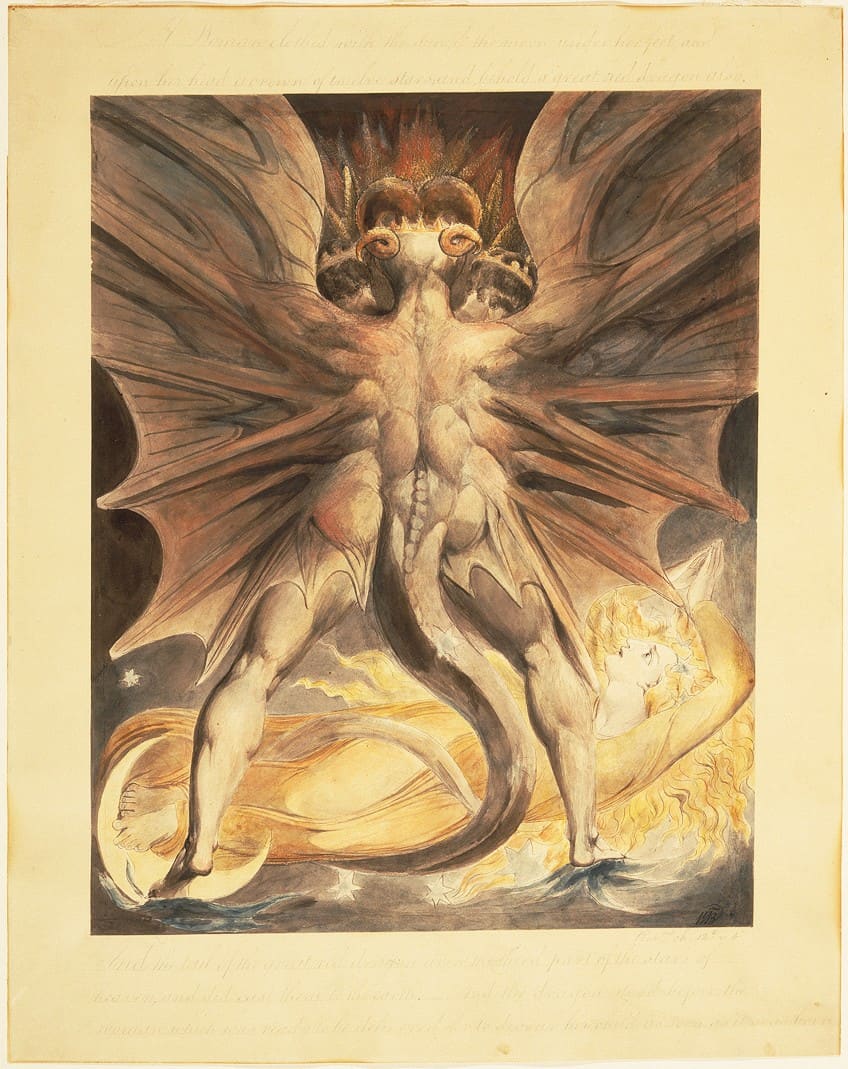
Subject Matter: Visual Description
The Great Red Dragon and the Woman Clothed in Sun by William Blake depicts a large, looming, and threatening dragon-like figure standing with its back to us, the viewers, over a woman who is lying horizontally at its feet; her head is to the right and her feet are to the left. The dragon-like figure appears to have the morphology of a male human and a dragon, or some serpentine creature.
It has large, opened wings, which fill up most of the top half of the composition, thick curled horns on its head, and also has a golden spiked crown on it.

It appears as if the dragon antagonist has two more heads in front of its central head, both of which also have horns and wear crowns. Lengthening out from its spine, which depicts several visible vertebrae, is a long and solid tail trailing on the ground. It is standing wide-legged with muscularly pronounced legs, and seemingly typical to that of an athletic or strongly built man. Furthermore, its back is built with bulbous muscles, which further indicates the strength and solidity of this creature.
The woman lying on the ground is a softer and gentler contrast compared to the creature who is attempting to dominate her. She is bedecked with a golden radiance and indeed a personification of the Biblical text that states she is “clothed with the sun”.

There is also a crescent-shaped moon at her feet with part of her left foot’s toes visible on it, as well as several stars strewn around her and in her hair. You can also notice a star on the dragon’s tail. Her hair appears as long curls with each lock like streaming sun rays. Her hands are held in a gesture of prayer above her head, and she has a fearful facial expression.
Color
The Great Red Dragon and the Woman Clothed in Sun by William Blake notably depicts an earthy color scheme without any stark contrasting colors except for the more brilliant, but pale golden yellow from the woman lying under the dragon. The dragon appears in light brown or gray contrasts. The upper half of the composition has a darker, almost black, background compared to the lower half, which appears light gray due to the woman who is almost like a light source.
The contrast of light and dark in both halves of the composition can also refer to the ideas of good and evil.
Texture
William Blake composed The Great Red Dragon and the Woman Clothed in Sun in ink and watercolor, and with these, he created rich implied textures, from the more tendinous and thinner membranes of the dragon’s outstretched wings to the softer, diaphanous textures of the woman’s dress.
The composition also communicates hard and soft textures, notably the upper half, which the dragon composes, and that has a harder and sturdier quality compared to the more ethereal quality of the lower half, which the woman composes.
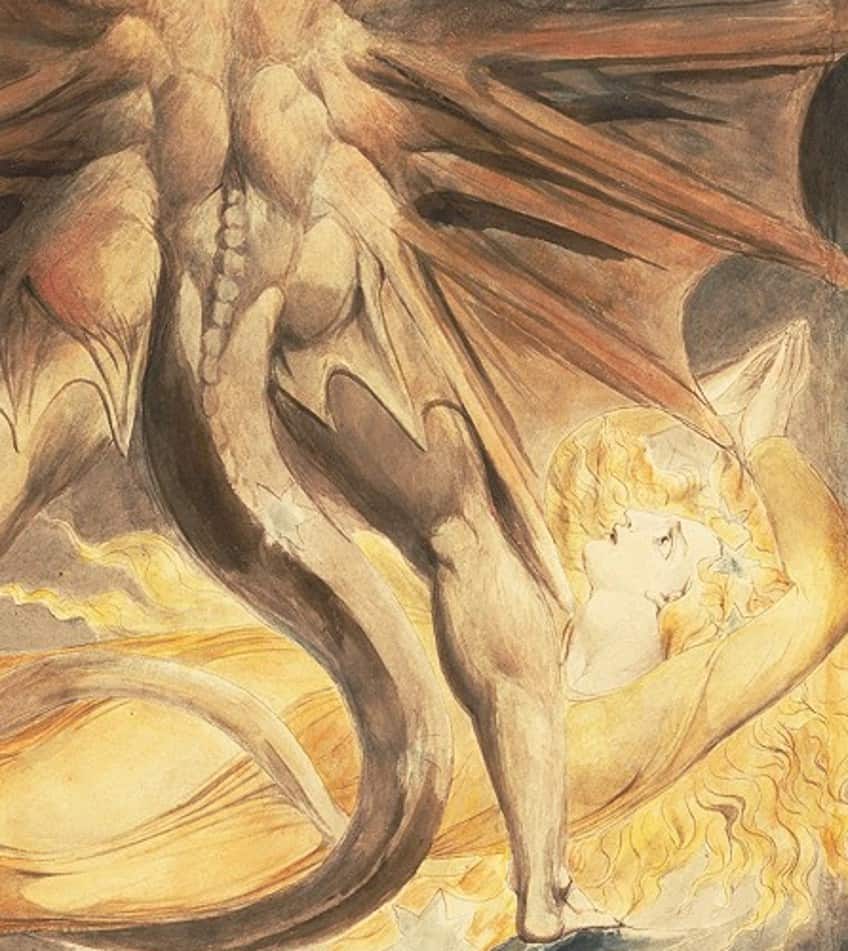
Line
There is a dynamic arrangement of lines creating the composition, most strikingly are the diagonal lines emanating from the dragon’s wings and the strong vertical placement the beast-like creature projects, although his back is to us, the viewers. This is heightened by his long, thick tail (and his muscular legs) extending the verticality.
There is a horizontal line implied by how the woman is placed in the composition, creating another contrasting effect.
Due to Blake’s artistic style for this composition, ink, and watercolors, the physical lines from these techniques are evident in the general outlines around the figures. Examples include the curling lines delineating the woman’s hair, the outlines of the stars, and the general outlines around the figures.
Shape and Form
The shapes and forms dominant in The Great Red Dragon and the Woman Clothed in Sun by William Blake appear naturalistic regardless of the more otherworldly subject matter, from the more reptilian and angular shapes of the dragon’s wings to the more rounded forms of the dragon’s back muscles.
Additionally, through shading William Blake created three-dimensional effects that enhanced the dragon’s muscular curvature, which also creates emphasis on its solid and threatening nature.
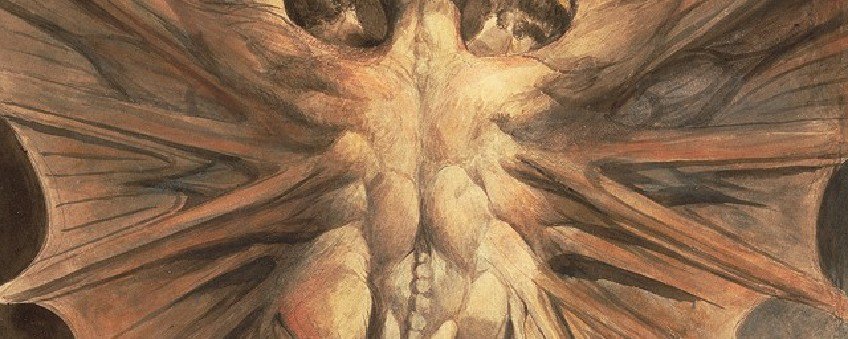
The woman’s body posture creates a horizontal, almost columnar, shape, but there is also a three-dimensionality of her form, which is dominantly curved. Apart from the curved forms of the dragon and woman, there are other more geometric shapes created by the stars and the crescent shape of the moon, but the composition appears balanced with a variety of shapes and forms that create unity.
Space
William Blake fills the compositional space with a great beastly figure whose wings span the left and right borders reaching into the upper corners into a space out of our, the viewers, view. The lower portion of the composition is more open, and we see through the spaces created by the dragon’s legs where the woman is lying.
In this case, the dragon figure and woman are the positive space, and the background comprises the negative space.
William Blake’s Dualisms
This article explored The Great Red Dragon and the Woman Clothed in Sun by William Blake, which is a composition of visual and philosophical contrasts that all interplay with the other, from hard to soft, solid to ethereal, good to evil, and the most primeval, God versus the Devil.
William Blake was known for his more “mystical” outlook on life, and many have described him as a “mad” man; he drew inspiration from what many have stated were his “visions”. He was also inspired by the literary texts, notably poetry, from writers like John Milton, who wrote the famous “Paradise Lost” (1667) among others; however, what we have come to learn from Blake is that his visual compositions also convey a sense of the everyday world that he found himself in and the socio-political events that took place, giving rise to a true dualism that we could say are between the cosmic and earthly, and seemingly William Blake was rooted in between both worlds.
Frequently Asked Questions
What Are William Blake’s Dragon Paintings?
There are several versions of William Blake’s dragon painting that depict a scene from the Holy Bible’s The Book of Revelation (c. 96 CE), Chapter 12, in which a woman, the Virgin Mary, is about to give birth to Jesus Christ and the Devil wants to destroy Him.
What Is the Location of The Great Red Dragon and the Woman Clothed in Sun by William Blake?
The Great Red Dragon and the Woman Clothed in Sun by William Blake is held at the Brooklyn Museum in New York City with three other versions: The Great Red Dragon and the Woman Clothed With the Sun (c. 1805) and The Great Red Dragon and the Beast from the Sea (c. 1805) are both at the National Gallery of Art in Washington D.C., but The Number of the Beast is 666 (c. 1805) is housed at the Rosenbach Museum and Library in Philadelphia. All of the above are located in the United States of America.
What Medium Is Used in William Blake’s Dragon Paintings?
William Blake painted in watercolors with ink and graphite, and he was an engraver and printmaker, which was one of his main forms of artmaking. He reportedly also worked with oil paints but did not prefer them.
Alicia du Plessis is a multidisciplinary writer. She completed her Bachelor of Arts degree, majoring in Art History and Classical Civilization, as well as two Honors, namely, in Art History and Education and Development, at the University of KwaZulu-Natal, South Africa. For her main Honors project in Art History, she explored perceptions of the San Bushmen’s identity and the concept of the “Other”. She has also looked at the use of photography in art and how it has been used to portray people’s lives.
Alicia’s other areas of interest in Art History include the process of writing about Art History and how to analyze paintings. Some of her favorite art movements include Impressionism and German Expressionism. She is yet to complete her Masters in Art History (she would like to do this abroad in Europe) having given it some time to first develop more professional experience with the interest to one day lecture it too.
Alicia has been working for artincontext.com since 2021 as an author and art history expert. She has specialized in painting analysis and is covering most of our painting analysis.
Learn more about Alicia du Plessis and the Art in Context Team.
Cite this Article
Alicia, du Plessis, ““Great Red Dragon and the Woman Clothed in Sun” – William Blake.” Art in Context. March 14, 2023. URL: https://artincontext.org/great-red-dragon-and-the-woman-clothed-in-sun/
du Plessis, A. (2023, 14 March). “Great Red Dragon and the Woman Clothed in Sun” – William Blake. Art in Context. https://artincontext.org/great-red-dragon-and-the-woman-clothed-in-sun/
du Plessis, Alicia. ““Great Red Dragon and the Woman Clothed in Sun” – William Blake.” Art in Context, March 14, 2023. https://artincontext.org/great-red-dragon-and-the-woman-clothed-in-sun/.







